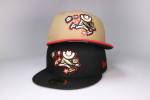What’s It Worth?
For the past 40 years, Aunt Esther's antique brooch has been resting in the dresser drawer next to the baseball card with Mickey Mantle's signature. Are they worth anything?
Wonder no more. On-site appraisers, knowledgeable in everything from brooches to baseball, will be at the Las Vegas Home Improvement and Decorating Show, Friday through April 29 at Cashman Center, 850 Las Vegas Blvd. North, appraising, educating and giving final answers to that nagging question, "Is this worth anything?"
Bee Wendler is an antique dealer and appraiser from Temecula, Calif. She has arranged for expert appraisers to review all the precious items people will be bringing in believing they own something worth thousands of dollars.
"Part of what we do is console people and tell them how nice an item it is but in reality, it's nothing special," said Wendler. "We'll be looking at paintings, clothing, postage stamps, board games, watches, chairs, books, just about anything you can think of."
Wendler suggests that if something is really large, for instance a buffet that was moved out from Massachusetts with the family's relocation, it is best to bring a photo with information that details the year the item was made, where it was made and by whom. Wendler explained that her team will not provide written appraisals. Everything evaluated will be done verbally, she said. Appraisals are priced at $10 for one item; $15 for two; and $20 for three or more.
Wendler's expertise is Victorian glass and furniture, and she said there is a difference between antiques and collectibles.
"For something to be an antique, it has to be at least 100 years old," said Wendler. "People come in all the time with something from the 1940s or '50s and it may have some value, but it's not an antique. That's like the difference between vase and vase. A vase that is less than 65 years old is pronounced with a long "a" -- anything older is pronounced with a short "a." I'm 75 years old, so something from the '50s is not an antique," she said. "It's a collectible."
Not only does Wendler have extensive knowledge about such items. She is a collector, as well.
Her personal assemblage includes nine epergnes -- ornate centerpieces with four- to eight-tiered flutes that hold flowers. They were made during 1850-1900 and are valued at $1,000 to $5,000 each.
If you're thinking about carting down a piece of furniture or two to have appraised, Wendler suggests pieces be free of staples, new nails or screws, and that glass items be free of stickers or residue. She has been appraising for so long that she can describe glass, bronze, brass and gold just by touching or feeling it.
"We honestly want to tell customers they have an antique or something of value when they bring in their items," said Wendler. "It's a thrill for us to find something that is valuable, and we're exhilarated when this happens."
While there are trends in collectibles and antiques, Wendler said estate jewelry is timeless, along with Tiffany glass and beautifully carved clocks.
"Things are just not made the same," she said. "So much is mass produced; even reproductions of older furniture are made quickly and cheaply. True craftsmen are still out there, but you have to search for them. That's why antiques are so valuable. They represent a different time and sense of pride."























